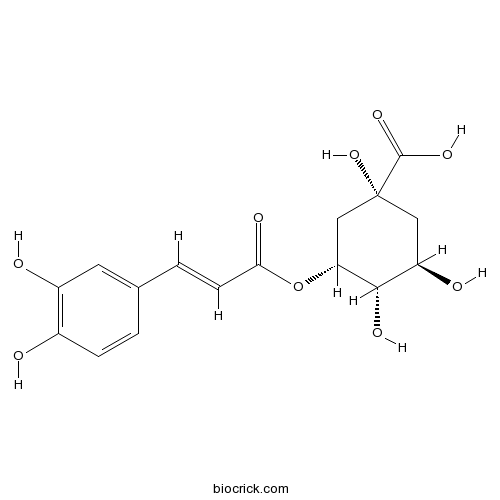A cinnamate ester obtained by formal condensation of the carboxy group of trans-caffeic acid with the 5-hydroxy group of quinic acid.
InChI=1S/C16H18O9/c17-9-3-1-8(5-10(9)18)2-4-13(20)25-12-7-16(24,15(22)23)6-11(19)14(12)21/h1-5,11-12,14,17-19,21,24H,6-7H2,(H,22,23)/b4-2+/t11-,12-,14+,16-/m1/s1
Neochlorogenic acid (NCA) is a natural polyphenolic compound found in dried fruits and other plants, has shown that phenolic acids including NCA have outstanding antioxidant, antibacterial, antiviral, and antipyretic activities, it also exerts neuroprotective effects through the inhibition of pro-inflammatory pathways in activated microglia.[1]
Neochlorogenic acid (NCGA), chlorogenic acid (CGA) and its isomer, were found to be the major phenolic compounds in the flesh and peel of three peach cultivars, the high concentrations of CGA and NGA in immature fruits might contribute to their reduced susceptibility or increased resistance to brown rot infection by interfering with fungal melanin production.[2]
Neochlorogenic acid and chlorogenic acid could be colon cancer suppressive components of the prune.[3]
English website: Neochlorogenic acid
Japanese website: Neochlorogenic acid
Chinese website: Neochlorogenic acid
[1] Kim M, Choi S Y, Lee P, et al. Neurochem Res, 2015, 40(9):1792-8.
[2] Villarino M, Sandín-España P, Melgarejo P, et al. J Agr Food Chem, 2011, 59(7):3205-13.
[3] Lee S O, Thurow T, Rom C R, et al. UARKive, 2012,5.
[4] Bing H E, Yang S Y, Yan Z. J Chinese Pharm Sci, 2012, 47(16):1280-4.



